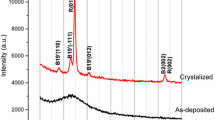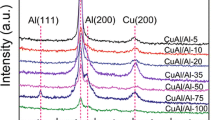Abstract
Heat treatment of γ-Ni(Al)/γ′-Ni3Al multilayer thin films demonstrates that multilayer hardness correlates with the magnitude of biaxial stress in alternating layers. Films with a columnar grain morphology and (001) texture were fabricated over a range of volume fraction and bilayer thickness via direct current magnetron sputtering onto NaCl (001) substrates at 623 K. The films were removed from substrates, heat-treated at either 673 K or 1073 K in argon, and then mounted for nanoindentation and x-ray diffraction. The biaxial stress state in each phase was furnished from x-ray diffraction measurement of (002) interplanar spacings. The 673 K treatment increases the magnitude of alternating biaxial stress state by 70 to 100% and increases hardness by 25 to 100%, depending on bilayer thickness. In contrast, the 1073 K heat treatment decreases the stress magnitude by 70% and decreases hardness by 50%. The results suggest that the yield strength of these thin films is controlled, in part, by the magnitude of internal stress. Further, thermal treatments are demonstrated to be an effective means to manipulate internal stress.
Similar content being viewed by others
References
W.C. Wang and R.N. Singh: Influence of the microstructure on the mechanical properties of Ni/Sn multilayered composites. Mater. Sci. Eng. A 271, 306 (1999).
V. Ramaswamy, M.A. Phillips, W.D. Nix, and B.M. Clemens: Observation of the strengthening of Pt layers in Ni/Pt and Pd/Pt multilayers by in-situ substrate curvature measurement. Mater. Sci. Eng. A 319–321, 887 (2001).
A. Misra and H. Kung: Deformation behavior of nanostructured metallic multilayers. Adv. Eng. Mater. 3, 217 (2001).
D. Josell, D. van Heerdan, D. Shechtman, and D. Read: Mechanical properties of multilayer materials. Nanostruct. Mater. 12, 405 (1999).
R. Banerjee, J.P. Fain, P.M. Anderson, and H.L. Fraser: Influence of crystallographic orientation and layer thickness on fracture behavior of Ni/Ni3Al multilayered thin films. Scripta Mater. 44, 2629 (2001).
T. Foecke and D.E. Kramer: In situ TEM observations of fracture in nanolaminated metallic thin films. International Journal of Fracture 119, 351 (2003).
P.M. Anderson, T. Foecke, and P.M. Hazzledine: Dislocationbased deformation mechanisms in metallic nanolaminates. MRS Bull. 24, 27 (1999).
D.E. Kramer, M.F. Savage, A. Lin, and T. Foecke: Novel method for TEM characterization of deformation under nanoindents in nanolayered materials. Scripta Mater. 50, 745 (2004).
G. Dehm, T.J. Balk, H. Edongue, and E. Arzt: Small-scale plasticity in thin Cu and Al films. Microelectron. Eng. 70, 412 (2003).
P.M. Anderson and C. Li: Crack-dislocation modeling of ductile-to-brittle transitions in multilayered materials, in Thin Films: Stresses and Mechanical Properties IV, edited by P.H. Townsend, T.P. Weihs, J.E. Sanchez, Jr., and P. Borgensen, (Mater. Res. Soc. Symp. Proc. 308, Pittsburgh, PA, 1993), p. 731.
A.V. Lamm and P.M. Anderson: Yield maps for nanoscale metallic multilayers. Scripta Mater. 50, 757 (2004).
Q. Li and P.M. Anderson: Dislocation confinement and ultimate strength in nanoscale metallic multilayers, in Mechanical Properties of Nanostructured Materials and Nanocomposites, edited by I. Ovid’ko, C.S. Pande, R. Krishnamoorti, E. Lavernia, and G. Skandan (Mater. Res. Soc. Symp. Proc. 791, Warrendale, PA, 2004) pp.131–136.
R.G. Hoagland, T.E. Mitchell, J.P. Hirth, and H. Kung: On the strengthening effects of interfaces in multilayer FCC metallic composites. Philos. Mag. A 82, 643 (2002).
R. Banerjee: M.S. Thesis, Ohio State University (1997).
G.B. Thompson: M.S. Thesis, Ohio State University (1998).
J.P. Fain: M.S. Thesis, Ohio State University (1999).
G.B. Thompson, R. Banerjee, X.D. Zhang, P.M. Anderson, and H.L. Fraser: Chemical ordering and texture in Ni-25 at% Al thin films. Acta Mater. 50, 643 (2002).
E.A. Sperling, R. Banerjee, G.B. Thompson, and J.P. Fain: Processing and microstructural characterization of sputter-deposited Ni/Ni3Al multilayered thin films. J. Mater. Res. 18, 979 (2003).
C.V. Thompson: Structure evolution during processing of polycrystalline films. Ann. Rev. of Mater. Sci. 30, 159 (2000).
N. Sridhar, J.M. Rickman, and D.J. Srolovitz: Multilayer film stability. J. Appl. Phys. 82, 4852 (1997).
R.L. Snyder and R. Jenkins: Introduction to Powder X-Ray Diffraction (John Wiley & Sons, New York, 1996).
J.L. Hay and G.M. Pharr: In ASM Handbook Volume 8: Mechanical Testing and Evaluation, edited by H. Kuhn and D. Medlin. (ASM International, Materials Park, OH, 2000), p. 232.
H.C. Barshilia and K.S. Rajam: Characterization of Cu/Ni multilayer coatings by nanoindentation and atomic force microscopy. Surf. Coat. Technol. 155, 195 (2002).
J. McKeown, A. Misra, H. Kung, R.G. Hoagland, and M. Nastasi: Microstructures and strength of nanoscale Cu-Ag multilayers. Scripta Mater. 46, 593 (2002).
R. Saha and W.D. Nix: Effects of the substrate on the determination of thin film mechanical properties by nanoindentation. Acta Mater. 50, 23 (2001).
D.L. Joslin and W.C. Oliver: A new method for analyzing data from continuous depth-sensing microindentation tests. J. Mater. Res. 5, 123 (1990).
K.B. Yoder, D.S. Stone, R.A. Hoffman, and J.C. Lin: Elastic rebound between an indenter and a layered specimen: Part II. Using contact stiffness to help ensure reliability of nanoindentation measurements. J. Mater. Res. 13, 3214 (1998).
Q. Li and P.M. Anderson: Dislocation-based modeling of the mechanical behavior of epitaxial metallic multilayer thin films (submitted).
A.V. Lamm and P.M. Anderson: In Processing and Properties of Structural Nanomaterials, edited by L.L. Shaw, C. Suryanarayana, and R.S. Mishra (TMS, Warrendale, PA, 2003), pp. 27–34.
P. Villars and L.D. Calvert, editors: Pearson’s Handbook of Crystallographic Data for Intermetallic Phases (ASM International, Materials Park, OH, 1996).
P.V.M. Rao, S.V. Suryanarayana, K.S. Murthy, and S.V.N. Naidu: The high-temperature thermal-expansion of Ni3Al measured by x-ray-diffraction and dilation methods. J. Phys: Condens. Matter. 1, 5357 (1989).
D.G. Pettifor: Theoretical predictions of structure and related properties of intermetallics. Materials Science and Technology Ser. 8, 345 (1992).
J.P. Fain, R. Banerjee, D. Josell, P.M. Anderson, H.L. Fraser, N. Tymiak, and W. Gerberich: Morphological stability of Ni(Al)/ Ni3Al nanolaminate composites, in Nanophase and Nanocomposite Materials III, edited by S. Komarnen; J.C. Parker, and H. Hahn (Mater. Res. Soc. Symp. Proc. 581, Warrendale, PA, 2000), pp. 603–608.
Author information
Authors and Affiliations
Corresponding author
Rights and permissions
About this article
Cite this article
Sperling, E.A., Anderson, P.M. & Hay, J.L. Correlation of stress state and nanohardness via heat treatment of nickel-aluminide multilayer thin films. Journal of Materials Research 19, 3374–3381 (2004). https://doi.org/10.1557/JMR.2004.0435
Received:
Accepted:
Published:
Issue Date:
DOI: https://doi.org/10.1557/JMR.2004.0435




